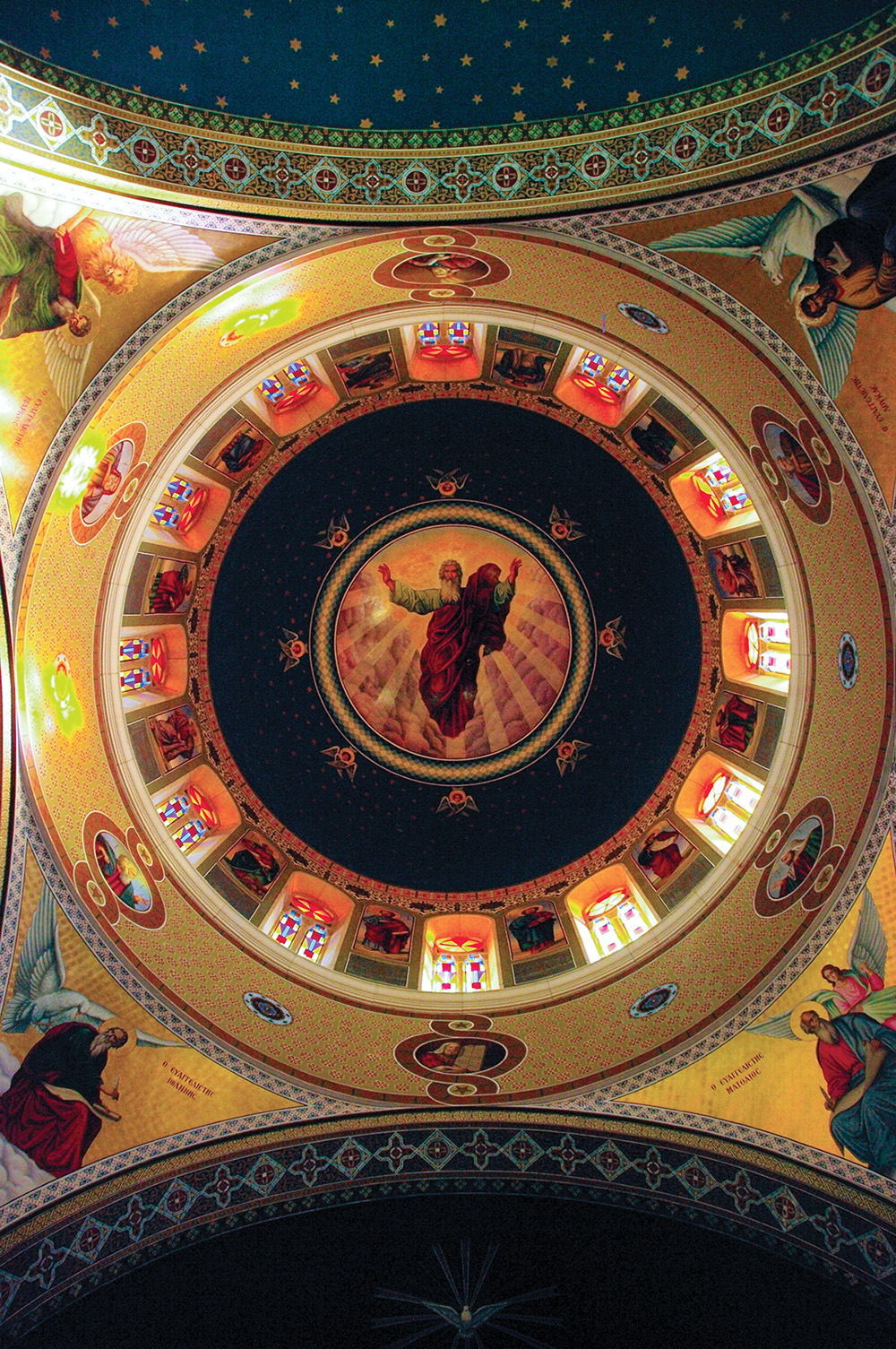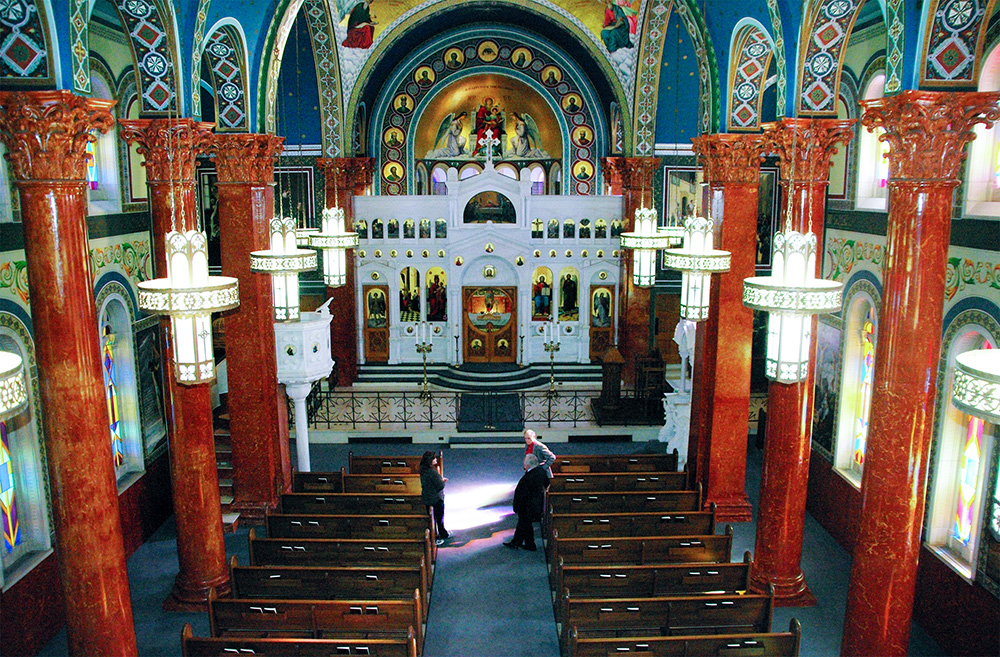
By Emmett Burnett
Malbis Memorial Church is often discovered accidentally while driving somewhere else. Commanding Alabama Highway 181 in Daphne is a Greek cathedral-like fortress, flanked with brick stone towers, braced in Corinthian columns, centered under a domed roof.
Somewhere else is now here.
“Here,” is the centerpiece of the Malbis Plantation, cornerstone of Baldwin County’s small but industrious Greek community, and legacy of the community and church’s namesake, Jason Malbis.
On a trip to Athens, shortly before his death, the Grecian forefather instructed followers to build his church in Malbis. And oh boy, did they.
Formally the “Sacred Patriarchal and Stavropegial Monastery of the Presentation of Theotoko,” the church has surprised and delighted visitors since day one with good reason. It is spiritual, reverent and eye popping.
“First timers can’t believe what they are seeing,” notes Nafseka Malbis, caretaker, tour guide and descendant of founder Jason Malbis. “For me, there is no one favorite item. Everything is special.”
The interior is detailed with hand-rendered frescos – paintings that adorn virtually every space. Art depicts the life of Christ chronicled from the Testaments. More than 150 paintings tell stories, including Christ before the High Priest, the Sermon on the Mount, Moses receiving the 10 Commandments, religious heroes and other Bible scenes.
“It is like art comes to life and speaks to you,” adds George Kalasountas, frequent visitor and fan. “Many have told me upon leaving the sanctuary, they’ve never seen anything like it and they are correct.”
Kalasountas, who came from Greece in 1956 and today is vice president of the Malbis Memorial Foundation, adds, “We have many Greek Orthodox Churches, but this is the cream of the crop. It is simply beautiful.”
The fresco murals took three master artists flown in from Greece nine months to complete. The rotunda features a portrait of God, the Almighty surrounded by 12 murals of disciples and religious leaders. Artist Spyros Tzouvaras hand painted the portraits from scaffolding 75 feet above the floor. He lay on his back, applying paint and brush strokes to the ceiling, rendering the images. It took him three months.
Hand carved figures were brought from Greece and assembled in the church. The bishop’s throne, pulpit and other features are carved in white marble extracted from the same Grecian mines that supplied the Parthenon millenniums earlier.
On the outside above massive oak doors are mosaics created with thousands of tiles about one-inch square. Above the middle door is a portrait of Jesus. Above him are images of Matthew, Mark, Luke and John; all are a composite of mosaic tiles. Each tiny piece was prepared in Italy, shipped to Malbis, and installed on site.

Outside, the left tower contains a bell system: 49 bell tone generators that at full volume can be heard six miles away. It is a call to worship, a reminder of Grecian heritage, and the legacy of an immigrant who dreamed of a new world in Baldwin County.
Jason Malbis was born Antonios Markopoulos in Doumena, Greece. But in his 40s, he moved to America for a new life. Joined by friend William Papageorge, the two searched Illinois, Oklahoma, Texas, Missouri, and Mississippi before buying 120 acres in Baldwin County for $5 an acre.
Others followed and more land was added to become The Malbis Plantation, established in 1906. “We had a bakery, power plant, bank, timber company, hotel, and farms,” Kalasountas recalls. “It was a self-sufficient. We all had jobs to do. We all had a place in the community.”
But they did not have a church – yet.
‘It is my desire that you build a church’
In the early 1940s Jason Malbis visited Athens, Greece, but could not return due to World War II disruptions. He became sick and died in Athens, July 22, 1942, but not before sending a letter to beloved Grecians of Baldwin County: “It is my desire that you build a church.”
By 1960, the Greek settlement of about 60 – mostly farmers, tradesmen and working people – spearheaded a fundraising drive of $1 million. Adjusted for inflation, that is more than $7 million today.
Groundbreaking was held in 1960, and Malbis Memorial Church was dedicated on Jan. 3, 1965. If you were Greek you were there. And on that day everybody was Greek.
“People came from everywhere,” Kalasountas says. “The line to get in went around the building and people were in tears upon leaving.”
A New York Times October 1965 review noted, “The church is unique in the United States. A visitor’s first reaction upon entering the building is one of awe. It is like being inside a rainbow.”
Amazingly, this grand cathedral is financed mainly by love and donations. The Malbis church has never held a formal congregation but conducts regularly scheduled worship services. The building is also open to the public from 9 a.m.-4 p.m. Monday-Saturday.
Through the years, concerns were raised about next door Daphne – Baldwin County’s largest city – continuing to expand, and possibly encroaching on Malbis. “I think we are OK,” Kalasountas says. “Daphne is a good place, but we are doing just fine here in Malbis, too.”
Though Jason Malbis never saw the church that bears his name, his remains are interred in a crypt inside. But you can feel his spirit saying, “Build my church.” Outside, adjacent to the church, 100 Grecian graves answer, “Mission accomplished.”





